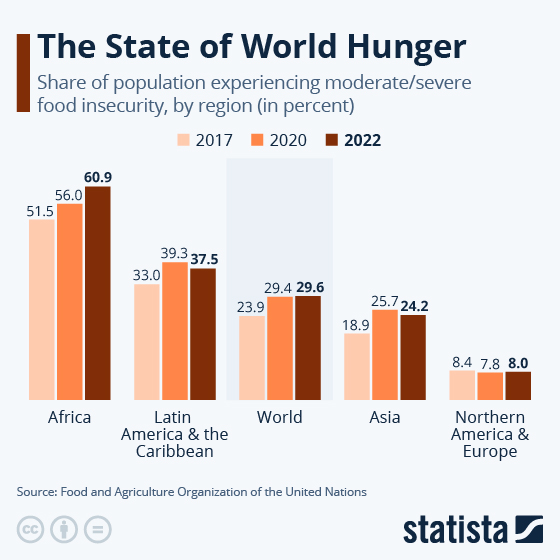
The global hunger crisis reached alarming heights in 2022, with at least 735 million people affected by hunger, as reported by the Food and Agriculture Organization of the United Nations (FAO). Nowhere is this crisis more severe than on the African continent, where food and nutrition security continue to fall unabated, posing significant challenges to the region’s economic, social, and political stability.
The Scope of the Crisis
According to the FAO, approximately 61 per cent of Africa’s population experienced moderate to severe food insecurity in 2022. This level of food insecurity encompasses a spectrum of issues ranging from insufficient funds to purchase healthy food, and problems with self-sufficiency, to severe conditions where individuals experience entire days without food. This marks a significant increase from previous years, up 9.4 percentage points from 2017 and 4.9 points higher than the levels seen during the first year of the Covid-19 pandemic.
Figure 1: Food Insecurity in Africa (2017-2022)
| Year | Moderate/Severe Food Insecurity |
| 2017 | 51.6% |
| 2020 | 56.1% |
| 2022 | 61.0% |
The data highlights a disturbing trend of escalating food insecurity that starkly contrasts with other regions of the world, which have seen a dip or plateau in hunger levels since the onset of the pandemic. This discrepancy is attributed to “an unequal pattern of economic recovery among countries and unrecovered income losses among those most affected by the pandemic.”
Comparative Analysis: Global Hunger Trends
While Africa’s hunger crisis intensifies, other regions have managed to stabilize or reduce their hunger rates. The FAO report notes that the most significant progress is expected in Asia, whereas no progress is foreseen in Latin America and the Caribbean. Alarmingly, hunger in Africa is projected to increase significantly by 2030.
Figure 2: Projected Hunger Trends (2030)
| Region | Projected Trend |
| Asia | Most progress expected |
| Latin America & Caribbean | No progress expected |
| Africa | Significant increase expected |
This projection underscores the urgent need for targeted interventions and robust international cooperation to address the underlying causes of food insecurity in Africa.
Underlying Causes and Contributing Factors
Several factors contribute to the persistent and growing hunger crisis in Africa:
- Economic Disparities: The economic recovery post-pandemic has been uneven, with many African countries struggling to regain their pre-pandemic economic status. The resultant income losses have disproportionately affected those already vulnerable, exacerbating food insecurity.
- Conflict and Displacement: Ongoing conflicts and political instability in various parts of Africa, such as the Sahel region and the Horn of Africa, have displaced millions, disrupting agricultural production and food supply chains.
- Climate Change: Extreme weather events, including droughts and floods, have become more frequent and severe, undermining agricultural productivity and food availability.
- Infrastructure Deficiencies: Inadequate infrastructure, particularly in rural areas, hampers the efficient distribution of food and other essential resources, contributing to localized food shortages.
- Policy and Governance Issues: Weak governance and policy implementation failures have impeded effective responses to food insecurity, further entrenching the crisis.

The Way Forward: Strategic Interventions
To combat the escalating hunger crisis in Africa, a multifaceted approach is essential. The following strategies should be prioritized:
- Strengthening Agricultural Resilience: Investment in climate-resilient agricultural practices and technologies can help mitigate the impact of extreme weather events on food production.
- Enhancing Economic Opportunities: Programs aimed at boosting economic growth and reducing inequality can help vulnerable populations regain their financial footing, improving access to food.
- Improving Infrastructure: Developing robust infrastructure, especially in rural areas, can facilitate better food distribution and reduce post-harvest losses.
- Promoting Peace and Stability: Efforts to resolve conflicts and promote political stability are crucial to ensuring that displaced populations can return to their homes and resume agricultural activities.
- International Cooperation: Enhanced collaboration between African governments, international organizations, and non-governmental organizations (NGOs) is vital to mobilize resources and implement effective food security programs.
Successful initiatives
Ghana’s Africa RISING Project
In Northern Ghana, the Africa RISING project has successfully improved the nutritional status of children and increased food security. The project focuses on sustainable agricultural practices and improving food production through climate-resilient farming techniques. This initiative has led to significant improvements in food availability and nutrition among local communities.
Ethiopia’s Productive Safety Net Programme (PSNP)
Ethiopia’s PSNP is one of the largest social protection programs in sub-Saharan Africa. It provides food or cash transfers to food-insecure households in exchange for participation in public works projects that build community assets, such as roads and irrigation systems. This dual approach has helped reduce the vulnerability of households to food insecurity while also improving infrastructure and agricultural productivity.
Somalia’s Baxnaano Program
The Baxnaano program, launched in 2019, has been instrumental in providing social safety nets to households facing chronic poverty and climate-related shocks. Over 1 million people have benefited from unconditional cash transfers to meet basic needs. During a major locust outbreak in 2020, the program scaled up to deliver emergency cash transfers to an additional 600,000 people, helping to secure their food and livelihoods. This initiative has been crucial in restoring trust in state-led social safety net systems.
Kenya’s Climate-Resilient Agriculture
In Kenya, various projects supported by the World Bank have promoted climate-resilient agriculture to combat food insecurity. These initiatives include the adoption of drought-resistant crops, improved irrigation techniques, and better water management practices. These efforts have led to increased agricultural productivity and reduced the impact of climate-related shocks on food security.
The escalating hunger crisis in Africa is a stark reminder of the vulnerabilities and inequalities that persist globally. While other regions have managed to stabilize or reduce their hunger levels, Africa’s food insecurity continues to rise, demanding urgent and concerted action. By addressing the root causes and implementing strategic interventions, it is possible to reverse this trend and pave the way for a more food-secure future for the continent.
Sources and References:
Food and Agriculture Organization of the United Nations (FAO). (2022).
“The State of Food Security and Nutrition in the World 2022.
“World Food Programme (WFP). (2022).
“Global Hunger Crisis: What’s Causing It?
“United Nations Office for the Coordination of Humanitarian Affairs (OCHA). (2022).
“Hunger and Food Insecurity.”International Food Policy Research Institute (IFPRI). (2023).
“Global Food Policy Report.”African Development Bank (AfDB). (2022).


